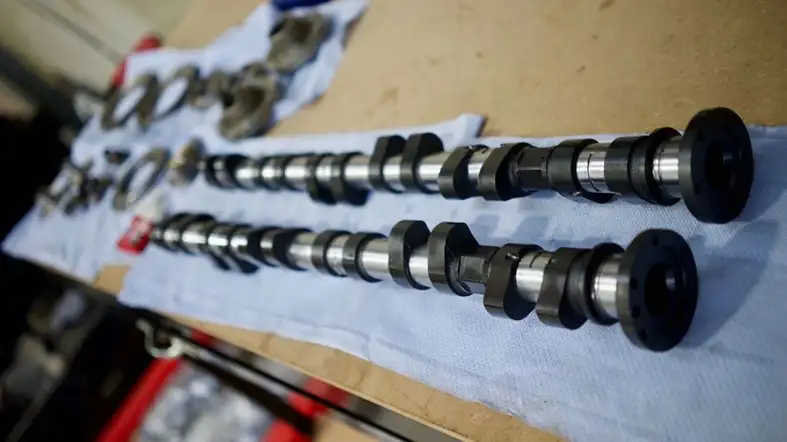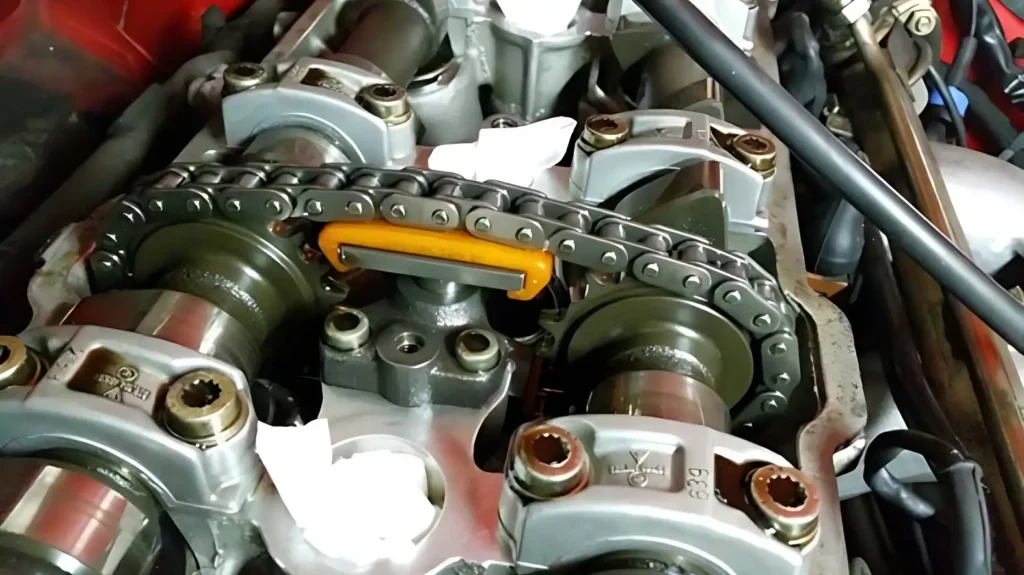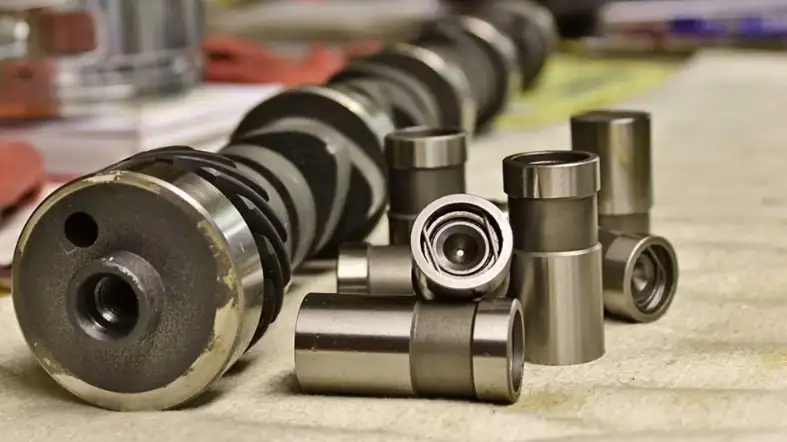Are you looking to improve the performance of your automobile? A camshaft upgrade could be the solution.
In this blog, we’ll discuss the pros and cons of upgrading your camshaft, as well as the factors to consider when choosing the right camshaft for your engine.
We’ll also provide some tips for maintaining and installing your camshaft upgrade.
Camshaft Upgrade Pros And Cons
Upgrading a camshaft can increase horsepower and torque, but may also reduce idle quality and increase fuel consumption.
Proper selection is important to ensure compatibility with other engine components.

Benefits of Camshaft Upgrades
Here are the benefits of Camshaft Upgrades
Improved Horsepower and Torque
One of the most significant benefits of upgrading your camshaft is an increase in horsepower and torque.
A camshaft with a higher lift and longer duration can increase the airflow into the engine, resulting in improved power output.
This upgrade can also improve the engine’s ability to produce torque, making your vehicle feel more responsive and powerful.
Better Throttle Response
Upgrading your camshaft can also improve your vehicle’s throttle response.
A performance camshaft can help your engine rev more quickly, resulting in a quicker response time when you hit the gas pedal.
This can enhance your driving experience, giving you a more exhilarating ride.
Enhanced Engine Sound
A camshaft upgrade can also improve the sound of your engine.
A performance camshaft with a more aggressive profile can produce a deeper, throatier exhaust note, giving your vehicle a more distinctive sound.
This can be especially appealing to car enthusiasts who want their vehicle to sound as good as it performs.
Increased Fuel Efficiency
While it may seem counterintuitive, upgrading your camshaft can also improve your vehicle’s fuel efficiency.
A performance camshaft can increase the airflow into the engine, which can result in a more complete combustion process.
This can improve the engine’s fuel efficiency, helping you get more miles per gallon.
Customization Options
Upgrading your camshaft also provides you with a variety of customization options.
There are many different camshaft profiles available, each with its own unique characteristics.
This means you can choose a camshaft that is tailored to your specific needs, whether you’re looking for improved horsepower, torque, or throttle response.
Drawbacks of Camshaft Upgrades

Increased Wear and Tear
One of the main drawbacks of camshaft upgrades is that they can cause increased wear and tear on your engine.
When you install a new camshaft, it changes the way that your engine’s valves open and close, which can put additional stress on other components, such as your lifters, pushrods, and rocker arms.
Over time, this added stress can cause these parts to wear out more quickly, leading to costly repairs and potential engine failure.
Reduced Low-End Torque
Another issue with camshaft upgrades is that they can reduce your engine’s low-end torque, which is the amount of rotational force your engine produces at low speeds.
Camshaft upgrades are designed to increase your engine’s high-end power, which means that they often sacrifice low-end torque in the process.
This can make your car feel sluggish at low speeds, and may even make it more difficult to drive in stop-and-go traffic.
Increased Fuel Consumption
In addition to reduced low-end torque, camshaft upgrades can also lead to increased fuel consumption.
This is because camshaft upgrades often require modifications to your engine’s fuel and air delivery systems in order to work properly.
These modifications can cause your engine to consume more fuel, which can be costly in the long run, especially if you use your car as a daily driver.
Increased Emissions
Finally, camshaft upgrades can also lead to increased emissions from your car.
This is because camshaft upgrades often require modifications to your engine’s exhaust system, which can alter the way that your car’s emissions are regulated.
In some cases, this can cause your car to produce more pollutants than it would with a stock camshaft, which can be harmful to the environment and may even cause your car to fail emissions tests.
Cost
A camshaft upgrade can be a costly modification, especially if other components such as valve springs, pushrods, and lifters need to be replaced as well.
Additionally, installation costs can be high if the upgrade requires significant engine disassembly.
Pros And Cons Of Small, Mild, And Big Camshaft Upgrade

Each type offers its own set of advantages and disadvantages, and it’s essential to understand them before deciding which one to install in your engine.
Small Camshaft Upgrade:
A small camshaft upgrade involves installing a camshaft with a slightly higher lift and duration than the stock camshaft.
This type of upgrade is generally considered to be the most conservative option, offering a relatively modest increase in power and torque.
Pros:
- A small camshaft upgrade can improve low-end torque, making the vehicle more responsive and easier to drive in stop-and-go traffic.
- It can also improve fuel efficiency by increasing the engine’s breathing ability, allowing it to operate more efficiently.
- A small camshaft upgrade typically doesn’t require other modifications, such as stiffer valve springs, which can save money and reduce installation time.
Cons:
- The power gains from a small camshaft upgrade are relatively modest, usually adding around 10-20 horsepower, depending on the engine’s size and other modifications.
- It may not provide the desired increase in performance for some enthusiasts who are looking for more significant power gains.
Mild Camshaft Upgrade:
A mild camshaft upgrade involves installing a camshaft with a more aggressive profile than the stock camshaft.
It typically offers a more substantial increase in power and torque than a small camshaft upgrade.
Pros:
- A mild camshaft upgrade can significantly improve horsepower and torque, making the vehicle more enjoyable to drive, especially at higher RPMs.
- It can also improve the engine’s overall sound, giving it a more aggressive exhaust note.
- A mild camshaft upgrade is a cost-effective way to increase performance without making major modifications to the engine.
Cons:
- A mild camshaft upgrade typically requires stiffer valve springs to prevent valve float, which can add to the installation cost and time.
- It may require other modifications, such as a higher stall speed torque converter, to fully realize its potential, which can add to the overall cost.
Big Camshaft Upgrade:
A big camshaft upgrade involves installing a camshaft with the most aggressive profile, offering the most significant increase in power and torque.
This type of upgrade is typically reserved for high-performance engines and racing applications.
Pros:
- A big camshaft upgrade can provide the most substantial increase in horsepower and torque, making the vehicle extremely powerful and quick.
- It can also give the engine a unique and aggressive sound that many enthusiasts find appealing.
- A big camshaft upgrade is often necessary for serious racing applications, where maximum power output is essential.
Cons:
- A big camshaft upgrade requires significant modifications, including stiffer valve springs, pushrods, and possibly even cylinder head modifications, which can add significantly to the cost and installation time.
- It can also make the vehicle more difficult to drive in stop-and-go traffic, as the engine may have a rough idle and a narrow powerband.
Choosing the Right Camshaft Upgrade

Here is a guideline on how to choose the right Camshaft for upgrade:
Determine Your Engine’s Needs
Before choosing a camshaft, you need to understand your engine’s needs.
Consider factors such as your engine’s displacement, compression ratio, and intended use.
Camshafts come in a variety of profiles, each designed for a specific purpose.
For example, if you have a high-revving engine, you’ll want a camshaft with a higher lift and duration profile.
On the other hand, if you have a low-revving engine, you’ll want a camshaft with a lower lift and duration profile.
Step 2: Choose the Right Camshaft Type
Once you understand your engine’s needs, you can choose the right camshaft type.
There are four main types of camshafts: hydraulic flat tappet, solid flat tappet, hydraulic roller, and solid roller.
Hydraulic flat tappet camshafts are the most common and are suitable for most street applications.
Solid flat tappet camshafts are more aggressive and are designed for high-performance applications.
Hydraulic roller camshafts are more expensive but offer improved performance over flat tappet camshafts.
Solid roller camshafts are the most aggressive and are designed for race applications.
Consider the Camshaft’s Duration and Lift
The duration and lift of a camshaft are two critical factors to consider when choosing a camshaft upgrade.
Duration refers to the amount of time the valves stay open, while lift refers to the distance the valve travels when it opens.
A longer duration and higher lift profile will increase the amount of air and fuel that enters the engine, resulting in increased horsepower and torque.
However, it’s important to choose a camshaft that matches your engine’s capabilities.
If you choose a camshaft with too much duration and lift, it can cause your engine to run poorly or even fail.
Consult with a Professional
Choosing the right camshaft can be a complex process, and it’s easy to make mistakes.
It’s always a good idea to consult with a professional before making any major engine upgrades.
A professional can help you choose the right camshaft for your engine and driving needs, ensuring that you get the best performance and reliability possible.
Installation and Maintenance
Installing a camshaft upgrade can be a complex and time-consuming process that requires expertise and specialized tools.
It’s crucial to follow the manufacturer’s instructions carefully and to have the work done by a qualified mechanic.
Additionally, regular maintenance, such as checking valve lash and oil changes, is necessary to ensure that the camshaft and other components continue to function properly.
FAQs
What Is A Camshaft Upgrade, And Why Would I Want To Do It?
A camshaft upgrade involves replacing the stock camshaft in your engine with a higher performance camshaft.
The main reason to do this is to increase horsepower and torque, as well as to improve the overall performance of your engine.
What Are The Benefits Of A Camshaft Upgrade?
The main benefits of a camshaft upgrade include increased horsepower and torque, improved acceleration and throttle response, and a more aggressive exhaust note.
Additionally, some camshafts are designed to improve fuel efficiency, although this is less common.
What Are The Drawbacks Of A Camshaft Upgrade?
One potential drawback of a camshaft upgrade is that it can reduce the low-end torque of your engine, which can make it more difficult to drive in stop-and-go traffic.
Additionally, a high-performance camshaft can put additional stress on your engine’s valve train, which can increase wear and tear and reduce the lifespan of your engine.
What Kind Of Camshaft Should I Choose?
The type of camshaft you choose will depend on your specific needs and goals.
If you’re looking for a camshaft that will provide maximum power at high RPMs, you’ll want to choose a camshaft with a high lift and long duration.
If you’re looking for a camshaft that will provide more low-end torque, you’ll want to choose a camshaft with a lower lift and shorter duration.
How Difficult Is It To Install A New Camshaft?
Installing a new camshaft can be a complex process that requires a fair amount of mechanical knowledge and experience.
If you’re not comfortable working on your engine yourself, it’s best to have a professional mechanic do the installation for you.
Do I Need To Make Any Other Modifications To My Engine If I Upgrade The Camshaft?
Depending on the specific camshaft you choose, you may need to make additional modifications to your engine to get the most out of the upgrade.
This could include upgrading the valve springs, lifters, or rocker arms, or installing a new intake manifold or exhaust system.
Will A Camshaft Upgrade Effect The Emissions Output Of My Engine?
Yes, a camshaft upgrade can affect the emissions output of your engine and may cause your vehicle to fail emissions testing if the upgrade is too aggressive.
It’s important to research the emissions laws in your state or country before making any modifications to your engine.
Conclusion
Upgrading the camshaft can be an effective way to improve the performance of your vehicle, but it’s essential to understand the pros and cons before making any decisions.
A camshaft upgrade can provide increased power and torque, improved throttle response, better fuel efficiency, and an enhanced exhaust note.
However, it can also result in reduced low-end torque, decreased fuel efficiency, increased wear and tear, and high costs.
When choosing a camshaft upgrade, consider the intended use, camshaft type, duration and lift, compatibility, and installation and maintenance requirements.
